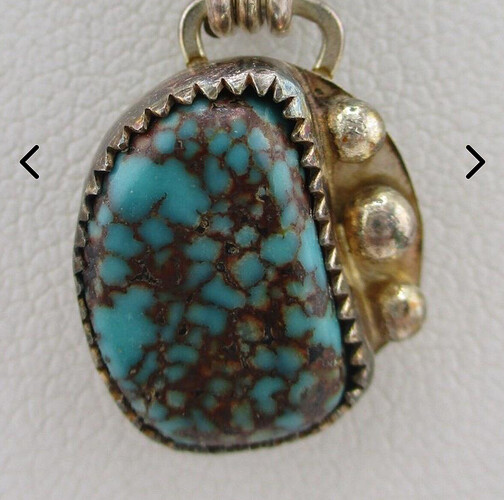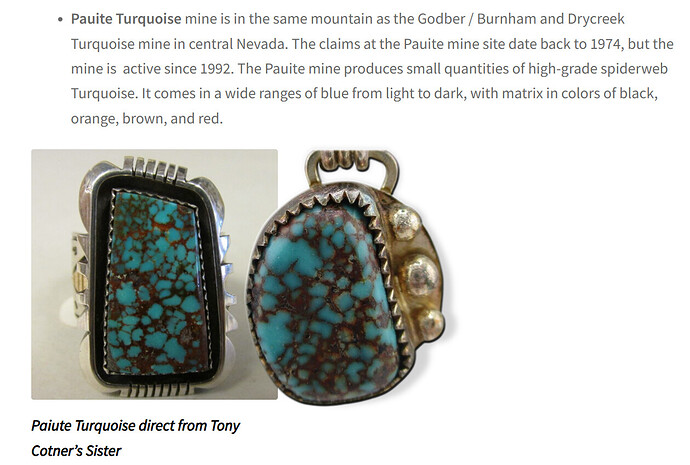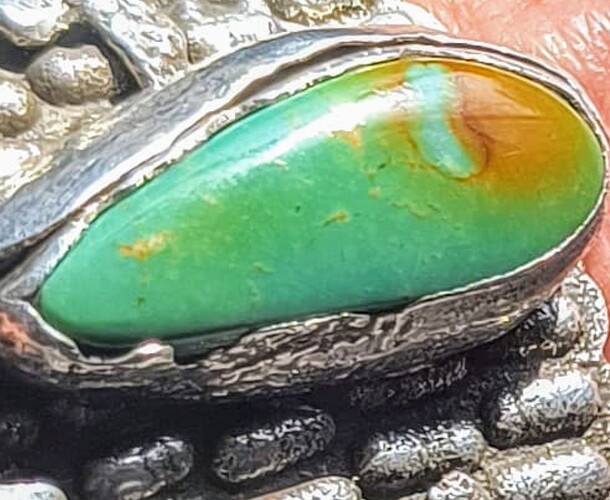What are your thoughts on this stone? Is it real or block?
I vote real but no idea of the mine.
@Emily Looks real, imo. One thing I do sometimes is gently drag a fingernail across the top of a mounted turquoise stone. Can you “feel” the matrix - tiny nicks, etc? Or, is it totally smooth with no resistance to your fingernail? Not saying this proves anything, it’s just something that I do. BTW, that’s a beautiful piece of turquoise!
I do that too!
20 characters…
I saw it online so I have no idea. I accidentally bid on it and won though, so I will let you know when I get it!
It’s real and a nice stone
Just to be sure … smooth is bad, right?
@gt75 Yes, I consider a totally smooth matrix to be questionable. Sort of my rule-of-thumb though there are exceptions to everything…
I would imagine in the majority of cases, but not all. I think where you could see smoothness is in higher grade natural stones. I have a few really nice stones that feel completely smooth, and I know they are real - natural even. But feeling some roughness of the matrix would definitely give me a clue that it’s not block.
Two of mine that are completely smooth are a Bisbee stone in my mom’s buckle, and one that I have no provenance for the mine (I do on the artist), but Jason thought it may be Indian Mountain (so pretty nice stones). Also I have a Zuni cuff with natural SB where all the stones are smooth (although TBH I haven’t examined every single one of them), but they are very small.
Another example, this one I have on now is completely smooth, and I know it’s real, because the artist is very well known. It’s Royston turquoise.
I agree with Patina in that unless I have bought something made by a familiar artist known for using nice stones or from a legit store, that complete smoothness of a stone could be a questionable thing for me also. And the vast majority of my turquoise has at least a small amount of roughness to it.
And here’s where I’m not sure, and I hope someone can chime in. I think sometimes stabilized turquoise can be polished better and have a higher shine and therefore maybe exhibit less roughness. But where it gets confusing to me is so can a high grade natural stone (take a high shine) versus a lower grade natural stone, which might look a little more waxy or matte (for lack of a better description). That’s where sometimes I can’t tell when something is stabilized, so price then can be an indication.
I’m certainly hoping they never get good enough making block turquoise that they fake rough matrix ![]()
I could be wrong, but I think the buffing/shaping of cabs plays a role in perceiving matrix texture.There’s been a lot of market preference for a so-called glassy surface, but then also some suppliers/jewelers who feature stones with little or low gloss and a very matrix-revealing surface. Quite a long time ago I purchased a gem-grade Tyrone turquoise bracelet with a serious “role” for the deep matrix, almost startlingly so.
That makes sense. I was surprised when I ran my thumb nail over the stone in the above picture, because it is smooth as glass, although it has less matrix in general. But in everything I’ve seen he uses natural stones (it’s Anthony Lovato). So I think what you’re saying is that how much matrix you feel may be a preference of the person who polishes it? The stones in my dad’s buckle have quite a bit of matrix that you can feel, but the Bisbee one in my mom’s is smooth as silk.
But in any case block wouldn’t have a matrix feel - they haven’t faked that yet that you’re aware of?
I probably shouldn’t have added my comment to this thread as OT, but we got into matrix so there we are. ![]() Block always has tells, no matter how it looks. I can imagine a simulation of matrix, but testing would still reveal what it is.
Block always has tells, no matter how it looks. I can imagine a simulation of matrix, but testing would still reveal what it is.


